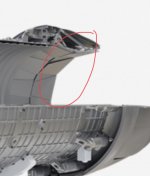TS1400 turbo shaft turbine inlet temperatures should not be too high. LHTEC CTS800 engine (ts1400 was based on the same radial flow design) has a TIT of 1050 degrees. When TS1400 was first made, to stress on the single crystals used, it was mentioned that the TIT could go as high as 1350 degrees C. - not necessarily the TIT value of TS1400. I don’t have the exact TIT values for TS1400. If you do I would appreciate it if you could share.
TF6000/10000 turbofan engines are being produced primarily as test bed engines for the KAAN’s prospective TF35000 engine. This engine is to contain technologies and specifics that would lead to an engine that can produce around 26000lbf dry and 35000lbf wet thrust similar to F119. Prof Aksit himself claimed that at TEI they could produce such an engine. Now proof of the pudding is in the eating.
To be used as test bed, TF6K is to contain third generation single Crystal blades, Blisk fans and compressors. Plus many parts being produced with additive technologies. F119 has a TIT value of 1649 degrees C and uses third generation single Crystal blades with Blisk fan and compressor sections. So TF6000 is being produced with similar tech on board. So I think it would be wrong to draw analogies between TF6K and TS1400. Next few months will be very enlightening for all.
I see, so I was wrong about the technological interconnect between the TS1400 and TF-6000. The TIT figure for the TS1400, which I was informed about to be around 1600K at emergency power output, was something I've read on this very forum, possibly on this thread.
So it should either be that I've misremembered the details (mixing up possible maximum temperature of TS1400 turbine blades as the actual maximum operational temperature of the engine) or the person who've published said figures was citing wrong information, be it intentional or not.
Nevertheless, I am still of the opinion that TF-6000 combustor exit temperature/turbine inlet temperature would at least be around the same ballpark of F404, thus TIT wouldn't be the major factor when it comes to the reason the two engines have such different thrust figures. I still think that the lower thrust is due to smaller engine core and thus lower MFR, as well as lower OPR.
Now going back to the part of the Defence Turkey article you have mentioned on your previous post, I actually find it funny what is conveyed in that paragraph.
by replacing the HP fan and LP turbine and rescaling the compressor, combustion chamber, and HP turbine.
Yeah, that's what we usually call a "new design". As much as it would be great to be able to simply "rescale" the engine and that it just works, it isn't as simple as that in reality. You are basically changing the entierty of the engine core at that point. I should say that there's quite an exaggeration at play on that assertion.
Talking about the level of technology applied on the TF-6000 as well as its role as a precursor, or 'demonstrator' if I can put it that way, for the TF-35000, it surely is very encouraging that there are said progresses being made, but there are obviously many more important aspects to an advanced low-bypass gas turbine if you want to compare it to an engine as advanced as F119, although it is basically 3 decades old technology at this point.
I get to see the "3rd generation single crystal blades" "blisks" "additive manufacturing" being repeteadly mentioned to highlight Turkish progress in the field of gas turbine manufacturing, but there are much more to the advanced manufacturing techniques and more importantly, design of the operationally capable and cost-effective low-bypass gas turbine. I'm sure you are already aware of such
@Yasar , but I just wanted to stress this again, so bear with me. So, although TF-6000 will be able to demonstrate at least part of the basic Turkish capabilities in designing and manufacturing indigenous turbofans, which is an important stepping stone for the TF-35000, what's probably more important about the TF-6000 is the effect of the program itself to the entire gas turbine industry and R&D ecosystem. It will basically introduce Turkiye to basic capabilities and infrastructures, an overall structure to develop more advanced and sophisticated gas turbines in the future. We are already seeing new facilities being built for TRMotor, for example.
Yes, we'll get to know more details about the TF-6000 and where Turkiye is currently at in terms of gas turbine technologies, but if we are talking about TF-35000, its still a very long shot.











